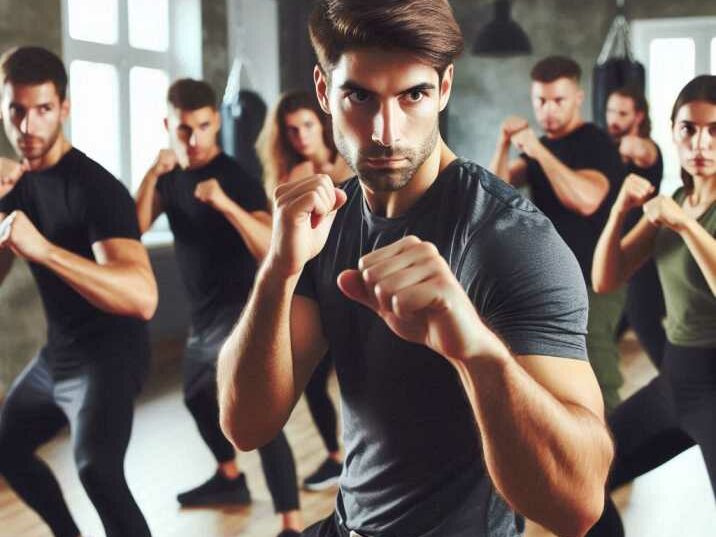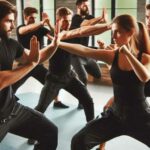Table of Contents
Table of Contents
- Introduction
- What is Krav Maga?
- Historical Origins of Krav Maga
- Core Principles of Krav Maga
- Is Krav Maga a Martial Art?
- Key Differences Between Krav Maga and Traditional Martial Arts
- Techniques and Training Methods in Krav Maga
- Real-Life Applications of Krav Maga
- The Psychological Aspect of what is Krav Maga
- Health and Fitness Benefits of Krav Maga
- Popularity and Global Reach of Krav Maga
- Frequently Asked Questions (FAQs)
- Conclusion
Introduction
Have you ever wondered Is Krav Maga a Martial Art? You’ve come to the right place. In this blog post, we’ll explore the unique world of Krav Maga, its roots, principles, and how it compares to traditional martial arts. By the end of this article, you’ll have a clear understanding of Krav Maga and why it’s considered one of the most effective self-defense systems.

What is Krav Maga?
Krav Maga, which means “contact combat” in Hebrew, is a self-defense system developed for the Israeli military. Unlike traditional martial arts, Krav Maga focuses on real-world situations with the primary goal of neutralizing threats quickly and efficiently.
Origins and Development
Krav Maga was created in the 1930s by Imi Lichtenfeld, a Hungarian-Israeli martial artist. Lichtenfeld’s experience in boxing, wrestling, and street fighting shaped the techniques and principles of Krav Maga, making it a practical and adaptable form of self-defense.
Key Principles
At its core, Krav Maga emphasizes simplicity, aggression, and quick resolution of conflicts. Techniques are designed to be easy to learn and apply, even under stress, making it an accessible system for people of all skill levels.
Historical Origins of Krav Maga
Understanding the history what is Krav Maga provides insight into its unique approach to self-defense.
The Birth of Krav Maga
Imi Lichtenfeld developed Krav Maga to help Jewish communities defend themselves against anti-Semitic attacks in 1930s Europe. His background in various fighting disciplines allowed him to create a practical system that prioritized effectiveness over tradition.
Military Adoption
In the 1940s, Lichtenfeld immigrated to Israel, where he began training soldiers in his self-defense techniques. Recognizing its effectiveness, the Israeli Defense Forces (IDF) adopted Krav Maga as their official combat system. Over time, it was refined and adapted for civilian use.
Global Spread
Today, Krav Maga is practiced worldwide by military personnel, law enforcement officers, and civilians. Its popularity continues to grow due to its practicality and effectiveness in real-life situations.
Core Principles of Krav Maga
Krav Maga’s principles set it apart from traditional martial arts.
Simplicity
Krav Maga techniques are designed to be straightforward and easy to remember, even under stress. This simplicity ensures that practitioners can quickly react to threats.
Aggression
Krav Maga emphasizes aggressive responses to threats. The goal is to neutralize the attacker as quickly as possible, using a combination of strikes, kicks, and other techniques.
Defending and Attacking
Unlike some martial arts that focus solely on defense, Krav Maga teaches practitioners to defend themselves while simultaneously attacking their opponent. This dual approach increases the chances of quickly ending a confrontation.
Is Krav Maga a Martial Art?
The question of whether Krav Maga is a martial art can be complex.
Defining Martial Arts
Traditional martial arts, such as karate, judo, and taekwondo, often have a rich history, cultural significance, and a focus on discipline and personal development.
Krav Maga’s Practical Focus
While Krav Maga shares some similarities with martial arts, its primary focus is on practical self-defense rather than tradition or sport. This emphasis on real-world applications sets it apart from many traditional martial arts.
Hybrid Approach
Some argue that Krav Maga is a hybrid system that combines elements of martial arts, boxing, wrestling, and street fighting. This blend of techniques makes it effective in various situations, but also challenges the traditional definition of a martial art.
Key Differences Between Krav Maga and Traditional Martial Arts
Understanding the distinctions between Krav Maga and traditional martial arts can help clarify its unique approach.
Training Objectives
Traditional martial arts often have a holistic approach, focusing on physical fitness, mental discipline, and spiritual growth. Krav Maga, on the other hand, prioritizes practical self-defense skills and rapid threat neutralization.
Techniques and Strategies
While traditional martial arts may emphasize forms, patterns, and techniques that have been passed down through generations, Krav Maga focuses on techniques that are adaptable to modern-day threats. This adaptability ensures that practitioners are prepared for various real-world scenarios.
Combat Philosophy
In traditional martial arts, there is often a focus on honor, respect, and avoiding unnecessary violence. Krav Maga’s philosophy is more aggressive, with an emphasis on doing whatever it takes to survive and escape a confrontation.
Techniques and Training Methods in Krav Maga
Krav Maga training encompasses a wide range of techniques and methods.
Striking Techniques
Krav Maga incorporates various strikes, including punches, elbows, knees, and kicks. These strikes are designed to target vulnerable areas of the body, such as the eyes, throat, and groin, to quickly incapacitate an attacker.
Defensive Maneuvers
Defensive techniques in Krav Maga focus on blocking and redirecting attacks. Practitioners learn to defend against common attacks, such as punches, grabs, and chokes, while simultaneously counter-attacking.
Scenario-Based Training
One of the hallmarks of Krav Maga training is scenario-based exercises. Practitioners are put in realistic situations to practice their skills under stress, simulating the adrenaline and chaos of a real-life confrontation.
Real-Life Applications of Krav Maga
Krav Maga’s effectiveness in real-world situations is a significant reason for its popularity.
Self-Defense for Civilians
Krav Maga provides civilians with practical self-defense skills that can be used in everyday situations, from muggings to assaults. Its focus on rapid threat neutralization ensures that practitioners can protect themselves and their loved ones.
Law Enforcement and Military Use
Law enforcement and military personnel around the world use Krav Maga for its practicality and effectiveness. It provides them with the skills needed to handle violent encounters and protect the public.
Personal Safety and Awareness
Beyond physical techniques, Krav Maga training also emphasizes the importance of situational awareness and personal safety. Practitioners learn to identify potential threats and avoid dangerous situations whenever possible.
The Psychological Aspect of what is Krav Maga
Krav Maga training goes beyond physical techniques, addressing the psychological aspects of self-defense.
Stress Management
Krav Maga practitioners learn to manage stress and maintain composure during confrontations. This ability to stay calm under pressure is crucial for making effective decisions and executing techniques.
Mental Toughness
Training in Krav Maga builds mental toughness and resilience. Practitioners develop the confidence and determination needed to face and overcome challenges, both in training and in real-life situations.
Overcoming Fear
Fear is a natural response to danger, but it can be paralyzing. Krav Maga training helps practitioners understand and manage their fear, allowing them to respond effectively to threats.
Health and Fitness Benefits of Krav Maga
In addition to its self-defense applications, Krav Maga offers numerous health and fitness benefits.
Physical Fitness
Krav Maga training is an intense workout that improves cardiovascular fitness, strength, endurance, and flexibility. Practitioners often see significant improvements in their overall physical health.
Weight Management
The high-intensity nature of Krav Maga training can help with weight management and fat loss. Regular practice burns calories and builds lean muscle, contributing to a healthier body composition.
Mental Health
Exercise is known to have positive effects on mental health, and Krav Maga is no exception. The physical activity, combined with the confidence and empowerment gained from training, can reduce stress, anxiety, and depression.
Popularity and Global Reach of Krav Maga
Krav Maga’s effectiveness and practicality have contributed to its widespread popularity.
Growing Popularity
Krav Maga has seen a surge in popularity in recent years, with more and more people seeking practical self-defense training. Its reputation as a highly effective system has attracted practitioners from all walks of life.
Global Reach
Krav Maga is now practiced in countries around the world. Schools and training centers offer classes for civilians, law enforcement, and military personnel, ensuring that the system’s benefits are accessible to a wide audience.
Influence on Other Systems
Krav Maga’s influence can be seen in the development of other self-defense systems and martial arts. Its principles and techniques have been adopted and adapted by various organizations, further cementing its impact on the world of self-defense.
Conclusion
Is Krav Maga a Martial Art? Krav Maga stands out as a highly effective and practical self-defense system, blending elements of martial arts, boxing, wrestling, and street fighting. Its emphasis on simplicity, aggression, and real-world applicability makes it a valuable tool for anyone seeking to protect themselves and their loved ones.
Whether you’re a beginner or an experienced martial artist, Krav Maga offers a unique and empowering approach to self-defense. By incorporating its principles and techniques into your training, you can enhance your physical fitness, mental toughness, and overall sense of security.
Ready to experience the benefits of Krav Maga for yourself? Sign up for a class at your local training center and start your journey toward mastering this powerful self-defense system.
Frequently Asked Questions (FAQs)
Is Krav Maga suitable for beginners?
Yes, Krav Maga is designed to be accessible for people of all skill levels. Beginners can start with basic techniques and gradually progress to more advanced training.
How long does it take to become proficient in Krav Maga?
The time it takes to become proficient in Krav Maga varies depending on the individual’s dedication and training frequency. Consistent practice and training can lead to significant improvement within a few months.
Can Krav Maga be used in sport competitions?
While Krav Maga is primarily focused on self-defense, some organizations offer competitive events that showcase techniques in a controlled environment. However, its main goal remains practical self-defense.
What should I wear to Krav Maga training?
Comfortable workout clothing and athletic shoes are recommended for Krav Maga training. Some schools may also require protective gear for certain drills and exercises.
Is Krav Maga effective for women?
Yes, Krav Maga is effective for women and men alike. Its techniques are designed to be practical and efficient, making it an excellent self-defense option for individuals of all genders.


